Exploring Social Work Theories in the Context of Australian Families
VerifiedAdded on 2023/05/30
|6
|1992
|380
Essay
AI Summary
This essay examines the application of social work theories to understand the dynamics within Australian families, considering Australia's unique history and diverse population. It addresses critical issues such as domestic violence, unemployment gaps among Aboriginal Australians, and the challenges faced by children in single-parent or step-families. The essay highlights the role of anti-oppressive theory in addressing social inequalities and the importance of cultural sensitivity in social work practice. It also discusses the ethical dilemmas faced by social workers when dealing with domestic violence cases and emphasizes the need for comprehensive support systems, preventive programs, and culturally tailored interventions to promote the well-being of Australian families and children. The conclusion underscores the significance of valuing cultural diversity and fostering respect within Australian society to ensure a thriving and inclusive environment for all families.
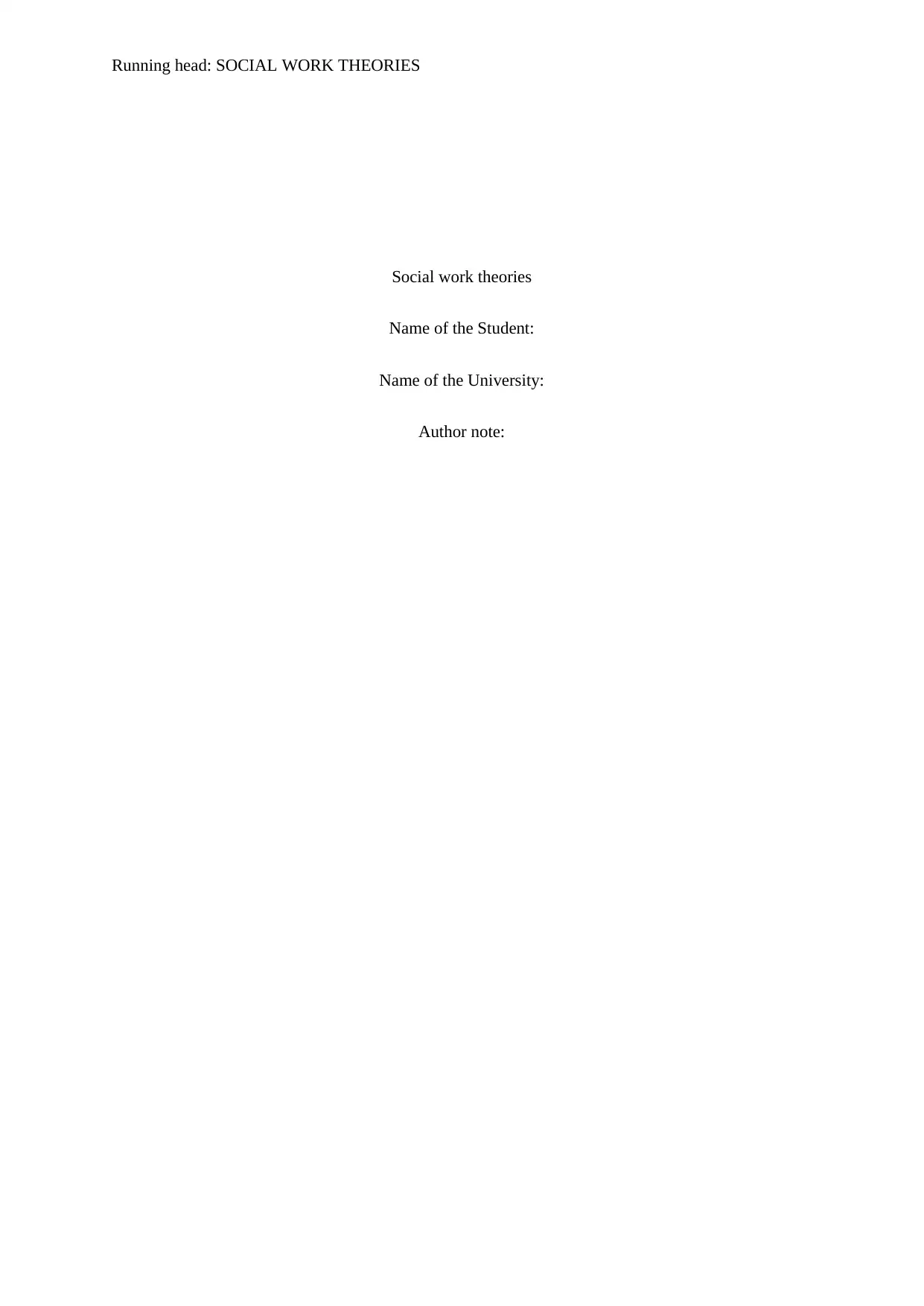
Running head: SOCIAL WORK THEORIES
Social work theories
Name of the Student:
Name of the University:
Author note:
Social work theories
Name of the Student:
Name of the University:
Author note:
Paraphrase This Document
Need a fresh take? Get an instant paraphrase of this document with our AI Paraphraser
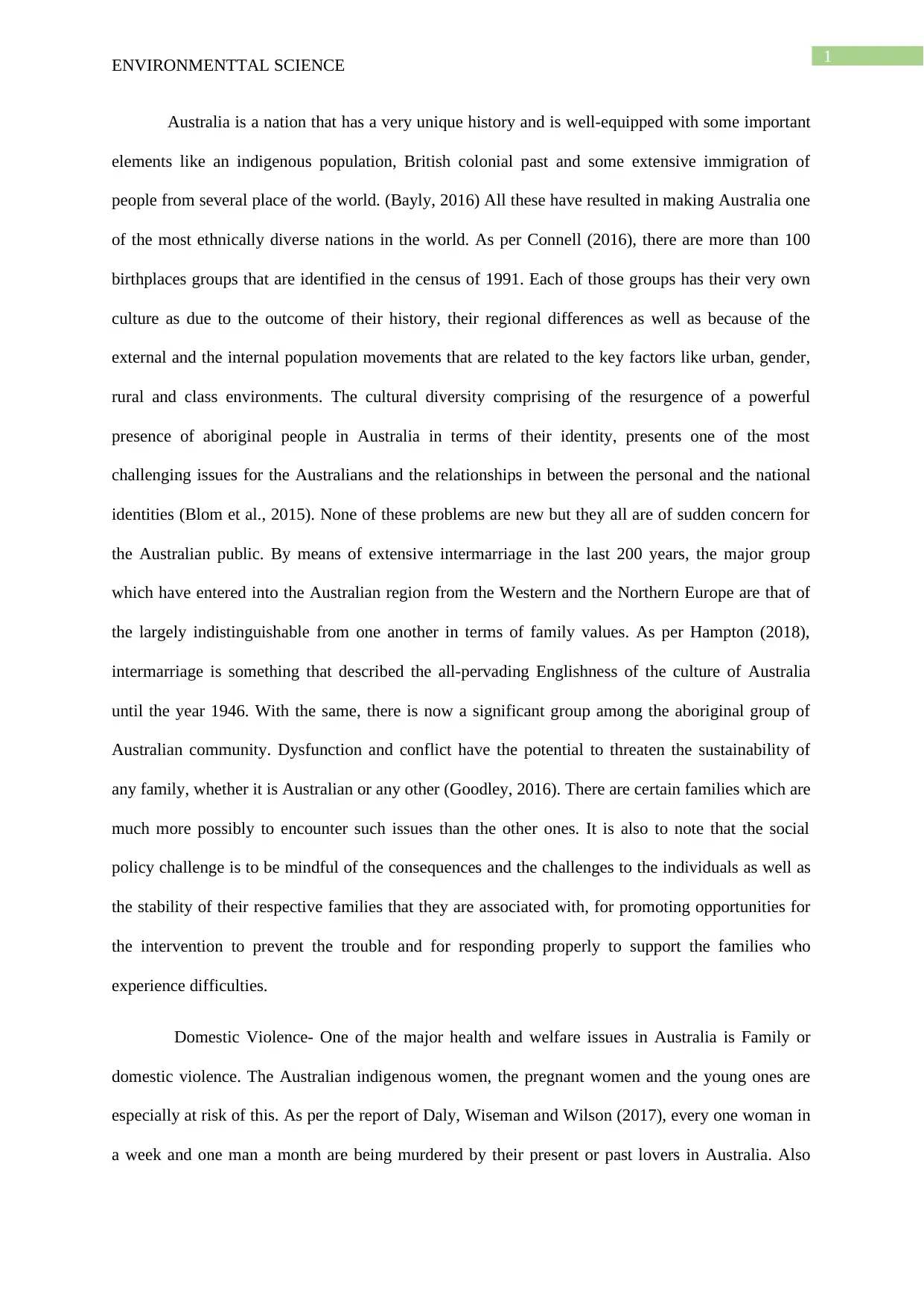
1
ENVIRONMENTTAL SCIENCE
Australia is a nation that has a very unique history and is well-equipped with some important
elements like an indigenous population, British colonial past and some extensive immigration of
people from several place of the world. (Bayly, 2016) All these have resulted in making Australia one
of the most ethnically diverse nations in the world. As per Connell (2016), there are more than 100
birthplaces groups that are identified in the census of 1991. Each of those groups has their very own
culture as due to the outcome of their history, their regional differences as well as because of the
external and the internal population movements that are related to the key factors like urban, gender,
rural and class environments. The cultural diversity comprising of the resurgence of a powerful
presence of aboriginal people in Australia in terms of their identity, presents one of the most
challenging issues for the Australians and the relationships in between the personal and the national
identities (Blom et al., 2015). None of these problems are new but they all are of sudden concern for
the Australian public. By means of extensive intermarriage in the last 200 years, the major group
which have entered into the Australian region from the Western and the Northern Europe are that of
the largely indistinguishable from one another in terms of family values. As per Hampton (2018),
intermarriage is something that described the all-pervading Englishness of the culture of Australia
until the year 1946. With the same, there is now a significant group among the aboriginal group of
Australian community. Dysfunction and conflict have the potential to threaten the sustainability of
any family, whether it is Australian or any other (Goodley, 2016). There are certain families which are
much more possibly to encounter such issues than the other ones. It is also to note that the social
policy challenge is to be mindful of the consequences and the challenges to the individuals as well as
the stability of their respective families that they are associated with, for promoting opportunities for
the intervention to prevent the trouble and for responding properly to support the families who
experience difficulties.
Domestic Violence- One of the major health and welfare issues in Australia is Family or
domestic violence. The Australian indigenous women, the pregnant women and the young ones are
especially at risk of this. As per the report of Daly, Wiseman and Wilson (2017), every one woman in
a week and one man a month are being murdered by their present or past lovers in Australia. Also
ENVIRONMENTTAL SCIENCE
Australia is a nation that has a very unique history and is well-equipped with some important
elements like an indigenous population, British colonial past and some extensive immigration of
people from several place of the world. (Bayly, 2016) All these have resulted in making Australia one
of the most ethnically diverse nations in the world. As per Connell (2016), there are more than 100
birthplaces groups that are identified in the census of 1991. Each of those groups has their very own
culture as due to the outcome of their history, their regional differences as well as because of the
external and the internal population movements that are related to the key factors like urban, gender,
rural and class environments. The cultural diversity comprising of the resurgence of a powerful
presence of aboriginal people in Australia in terms of their identity, presents one of the most
challenging issues for the Australians and the relationships in between the personal and the national
identities (Blom et al., 2015). None of these problems are new but they all are of sudden concern for
the Australian public. By means of extensive intermarriage in the last 200 years, the major group
which have entered into the Australian region from the Western and the Northern Europe are that of
the largely indistinguishable from one another in terms of family values. As per Hampton (2018),
intermarriage is something that described the all-pervading Englishness of the culture of Australia
until the year 1946. With the same, there is now a significant group among the aboriginal group of
Australian community. Dysfunction and conflict have the potential to threaten the sustainability of
any family, whether it is Australian or any other (Goodley, 2016). There are certain families which are
much more possibly to encounter such issues than the other ones. It is also to note that the social
policy challenge is to be mindful of the consequences and the challenges to the individuals as well as
the stability of their respective families that they are associated with, for promoting opportunities for
the intervention to prevent the trouble and for responding properly to support the families who
experience difficulties.
Domestic Violence- One of the major health and welfare issues in Australia is Family or
domestic violence. The Australian indigenous women, the pregnant women and the young ones are
especially at risk of this. As per the report of Daly, Wiseman and Wilson (2017), every one woman in
a week and one man a month are being murdered by their present or past lovers in Australia. Also
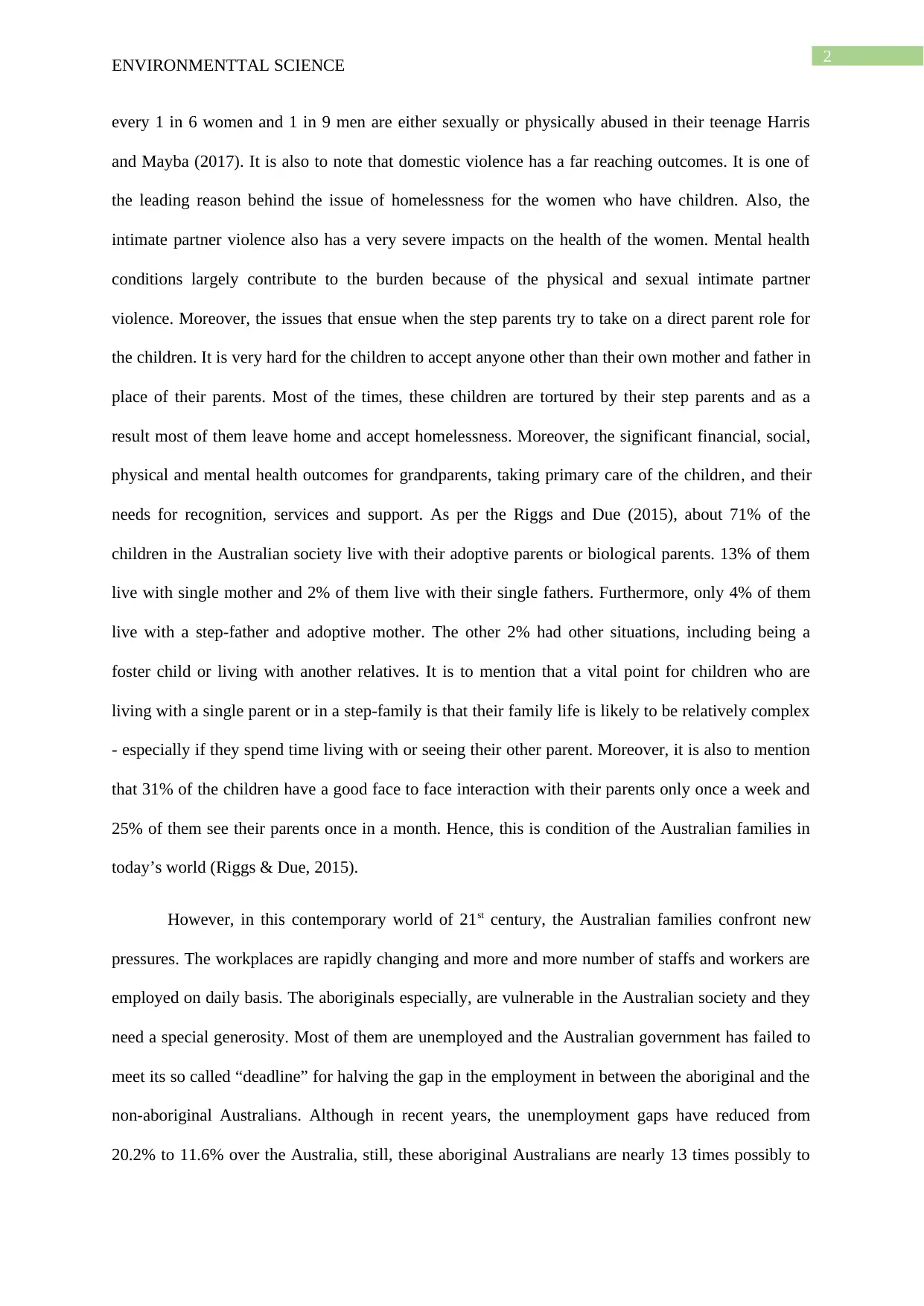
2
ENVIRONMENTTAL SCIENCE
every 1 in 6 women and 1 in 9 men are either sexually or physically abused in their teenage Harris
and Mayba (2017). It is also to note that domestic violence has a far reaching outcomes. It is one of
the leading reason behind the issue of homelessness for the women who have children. Also, the
intimate partner violence also has a very severe impacts on the health of the women. Mental health
conditions largely contribute to the burden because of the physical and sexual intimate partner
violence. Moreover, the issues that ensue when the step parents try to take on a direct parent role for
the children. It is very hard for the children to accept anyone other than their own mother and father in
place of their parents. Most of the times, these children are tortured by their step parents and as a
result most of them leave home and accept homelessness. Moreover, the significant financial, social,
physical and mental health outcomes for grandparents, taking primary care of the children, and their
needs for recognition, services and support. As per the Riggs and Due (2015), about 71% of the
children in the Australian society live with their adoptive parents or biological parents. 13% of them
live with single mother and 2% of them live with their single fathers. Furthermore, only 4% of them
live with a step-father and adoptive mother. The other 2% had other situations, including being a
foster child or living with another relatives. It is to mention that a vital point for children who are
living with a single parent or in a step-family is that their family life is likely to be relatively complex
- especially if they spend time living with or seeing their other parent. Moreover, it is also to mention
that 31% of the children have a good face to face interaction with their parents only once a week and
25% of them see their parents once in a month. Hence, this is condition of the Australian families in
today’s world (Riggs & Due, 2015).
However, in this contemporary world of 21st century, the Australian families confront new
pressures. The workplaces are rapidly changing and more and more number of staffs and workers are
employed on daily basis. The aboriginals especially, are vulnerable in the Australian society and they
need a special generosity. Most of them are unemployed and the Australian government has failed to
meet its so called “deadline” for halving the gap in the employment in between the aboriginal and the
non-aboriginal Australians. Although in recent years, the unemployment gaps have reduced from
20.2% to 11.6% over the Australia, still, these aboriginal Australians are nearly 13 times possibly to
ENVIRONMENTTAL SCIENCE
every 1 in 6 women and 1 in 9 men are either sexually or physically abused in their teenage Harris
and Mayba (2017). It is also to note that domestic violence has a far reaching outcomes. It is one of
the leading reason behind the issue of homelessness for the women who have children. Also, the
intimate partner violence also has a very severe impacts on the health of the women. Mental health
conditions largely contribute to the burden because of the physical and sexual intimate partner
violence. Moreover, the issues that ensue when the step parents try to take on a direct parent role for
the children. It is very hard for the children to accept anyone other than their own mother and father in
place of their parents. Most of the times, these children are tortured by their step parents and as a
result most of them leave home and accept homelessness. Moreover, the significant financial, social,
physical and mental health outcomes for grandparents, taking primary care of the children, and their
needs for recognition, services and support. As per the Riggs and Due (2015), about 71% of the
children in the Australian society live with their adoptive parents or biological parents. 13% of them
live with single mother and 2% of them live with their single fathers. Furthermore, only 4% of them
live with a step-father and adoptive mother. The other 2% had other situations, including being a
foster child or living with another relatives. It is to mention that a vital point for children who are
living with a single parent or in a step-family is that their family life is likely to be relatively complex
- especially if they spend time living with or seeing their other parent. Moreover, it is also to mention
that 31% of the children have a good face to face interaction with their parents only once a week and
25% of them see their parents once in a month. Hence, this is condition of the Australian families in
today’s world (Riggs & Due, 2015).
However, in this contemporary world of 21st century, the Australian families confront new
pressures. The workplaces are rapidly changing and more and more number of staffs and workers are
employed on daily basis. The aboriginals especially, are vulnerable in the Australian society and they
need a special generosity. Most of them are unemployed and the Australian government has failed to
meet its so called “deadline” for halving the gap in the employment in between the aboriginal and the
non-aboriginal Australians. Although in recent years, the unemployment gaps have reduced from
20.2% to 11.6% over the Australia, still, these aboriginal Australians are nearly 13 times possibly to
⊘ This is a preview!⊘
Do you want full access?
Subscribe today to unlock all pages.

Trusted by 1+ million students worldwide
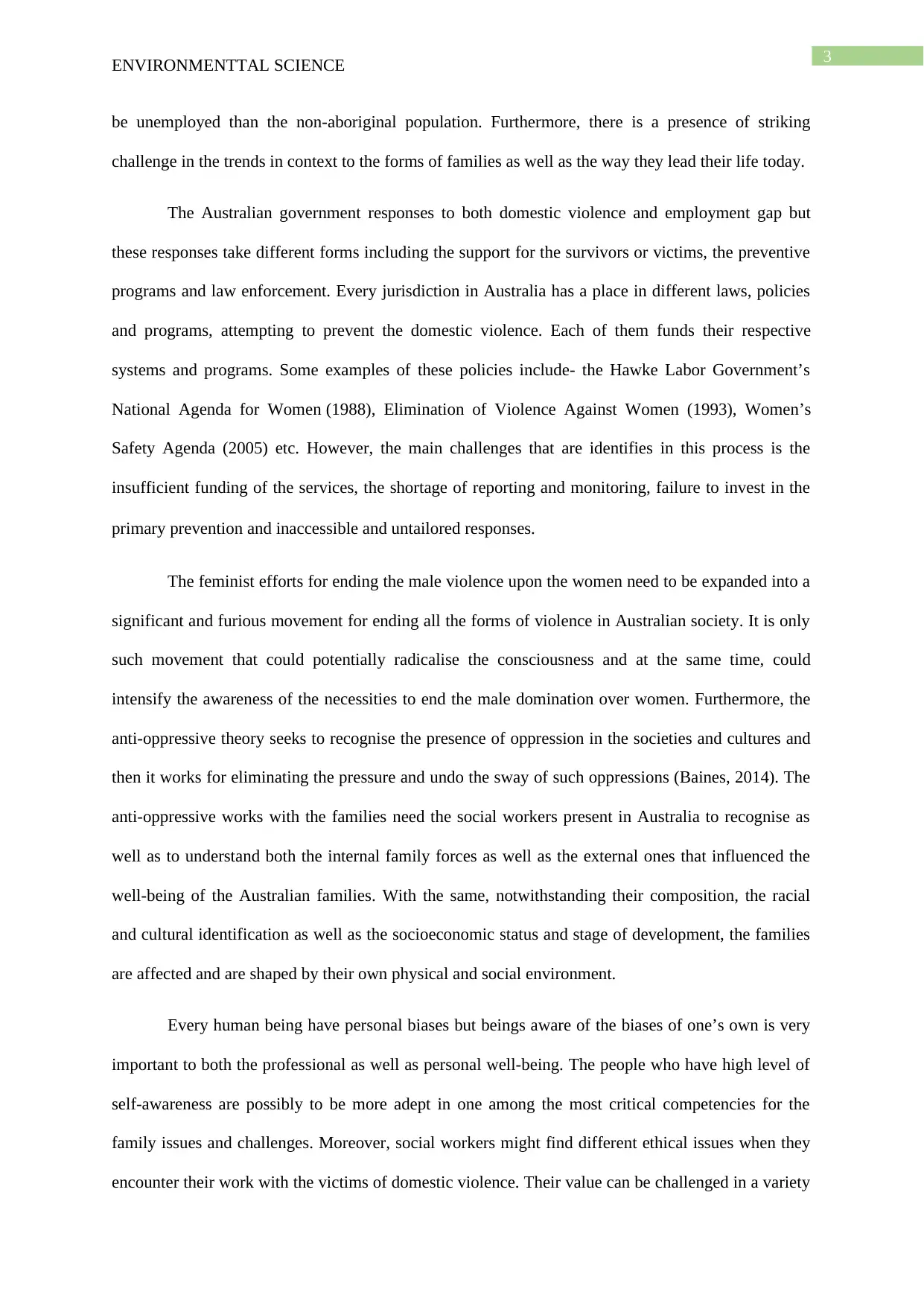
3
ENVIRONMENTTAL SCIENCE
be unemployed than the non-aboriginal population. Furthermore, there is a presence of striking
challenge in the trends in context to the forms of families as well as the way they lead their life today.
The Australian government responses to both domestic violence and employment gap but
these responses take different forms including the support for the survivors or victims, the preventive
programs and law enforcement. Every jurisdiction in Australia has a place in different laws, policies
and programs, attempting to prevent the domestic violence. Each of them funds their respective
systems and programs. Some examples of these policies include- the Hawke Labor Government’s
National Agenda for Women (1988), Elimination of Violence Against Women (1993), Women’s
Safety Agenda (2005) etc. However, the main challenges that are identifies in this process is the
insufficient funding of the services, the shortage of reporting and monitoring, failure to invest in the
primary prevention and inaccessible and untailored responses.
The feminist efforts for ending the male violence upon the women need to be expanded into a
significant and furious movement for ending all the forms of violence in Australian society. It is only
such movement that could potentially radicalise the consciousness and at the same time, could
intensify the awareness of the necessities to end the male domination over women. Furthermore, the
anti-oppressive theory seeks to recognise the presence of oppression in the societies and cultures and
then it works for eliminating the pressure and undo the sway of such oppressions (Baines, 2014). The
anti-oppressive works with the families need the social workers present in Australia to recognise as
well as to understand both the internal family forces as well as the external ones that influenced the
well-being of the Australian families. With the same, notwithstanding their composition, the racial
and cultural identification as well as the socioeconomic status and stage of development, the families
are affected and are shaped by their own physical and social environment.
Every human being have personal biases but beings aware of the biases of one’s own is very
important to both the professional as well as personal well-being. The people who have high level of
self-awareness are possibly to be more adept in one among the most critical competencies for the
family issues and challenges. Moreover, social workers might find different ethical issues when they
encounter their work with the victims of domestic violence. Their value can be challenged in a variety
ENVIRONMENTTAL SCIENCE
be unemployed than the non-aboriginal population. Furthermore, there is a presence of striking
challenge in the trends in context to the forms of families as well as the way they lead their life today.
The Australian government responses to both domestic violence and employment gap but
these responses take different forms including the support for the survivors or victims, the preventive
programs and law enforcement. Every jurisdiction in Australia has a place in different laws, policies
and programs, attempting to prevent the domestic violence. Each of them funds their respective
systems and programs. Some examples of these policies include- the Hawke Labor Government’s
National Agenda for Women (1988), Elimination of Violence Against Women (1993), Women’s
Safety Agenda (2005) etc. However, the main challenges that are identifies in this process is the
insufficient funding of the services, the shortage of reporting and monitoring, failure to invest in the
primary prevention and inaccessible and untailored responses.
The feminist efforts for ending the male violence upon the women need to be expanded into a
significant and furious movement for ending all the forms of violence in Australian society. It is only
such movement that could potentially radicalise the consciousness and at the same time, could
intensify the awareness of the necessities to end the male domination over women. Furthermore, the
anti-oppressive theory seeks to recognise the presence of oppression in the societies and cultures and
then it works for eliminating the pressure and undo the sway of such oppressions (Baines, 2014). The
anti-oppressive works with the families need the social workers present in Australia to recognise as
well as to understand both the internal family forces as well as the external ones that influenced the
well-being of the Australian families. With the same, notwithstanding their composition, the racial
and cultural identification as well as the socioeconomic status and stage of development, the families
are affected and are shaped by their own physical and social environment.
Every human being have personal biases but beings aware of the biases of one’s own is very
important to both the professional as well as personal well-being. The people who have high level of
self-awareness are possibly to be more adept in one among the most critical competencies for the
family issues and challenges. Moreover, social workers might find different ethical issues when they
encounter their work with the victims of domestic violence. Their value can be challenged in a variety
Paraphrase This Document
Need a fresh take? Get an instant paraphrase of this document with our AI Paraphraser
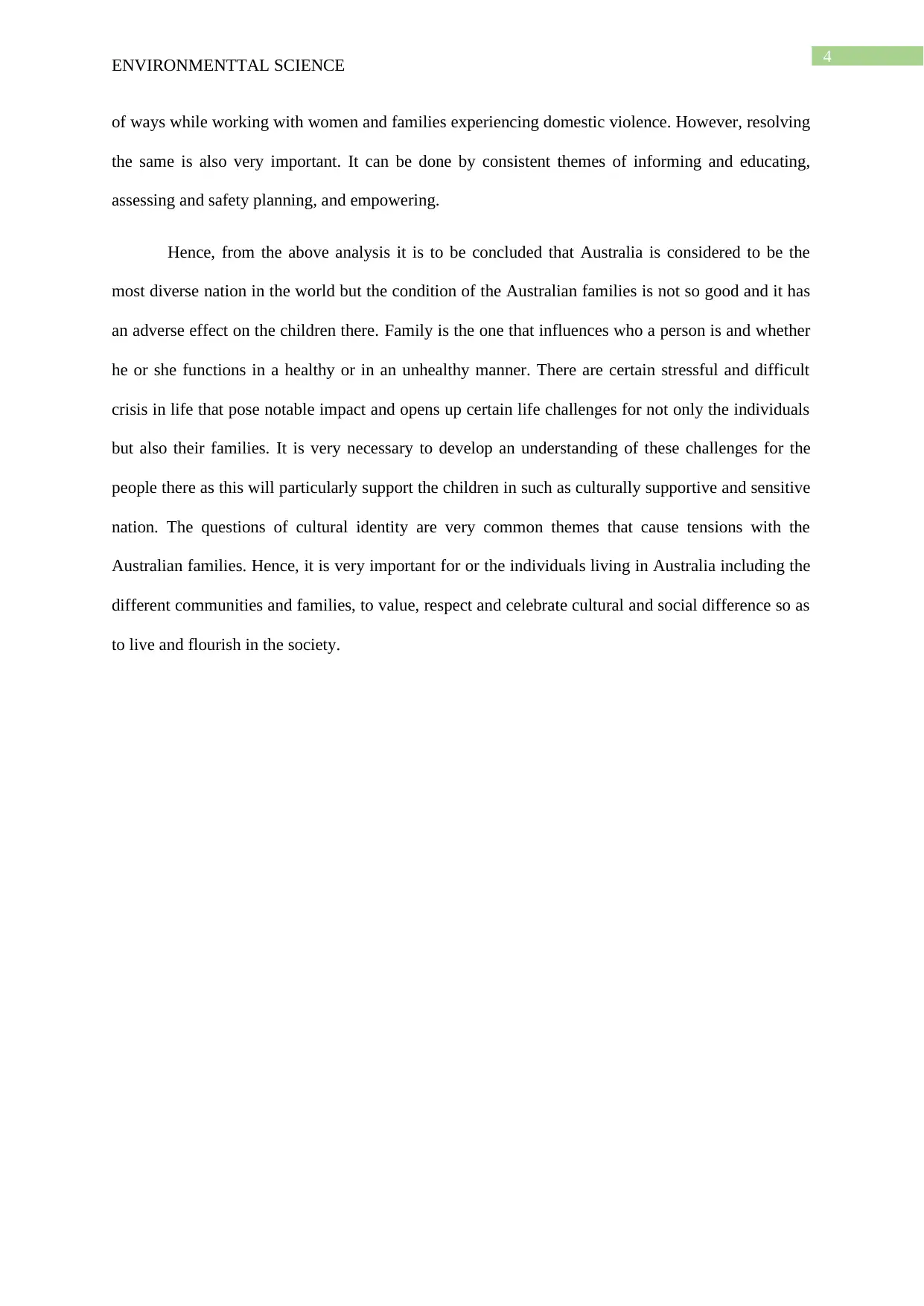
4
ENVIRONMENTTAL SCIENCE
of ways while working with women and families experiencing domestic violence. However, resolving
the same is also very important. It can be done by consistent themes of informing and educating,
assessing and safety planning, and empowering.
Hence, from the above analysis it is to be concluded that Australia is considered to be the
most diverse nation in the world but the condition of the Australian families is not so good and it has
an adverse effect on the children there. Family is the one that influences who a person is and whether
he or she functions in a healthy or in an unhealthy manner. There are certain stressful and difficult
crisis in life that pose notable impact and opens up certain life challenges for not only the individuals
but also their families. It is very necessary to develop an understanding of these challenges for the
people there as this will particularly support the children in such as culturally supportive and sensitive
nation. The questions of cultural identity are very common themes that cause tensions with the
Australian families. Hence, it is very important for or the individuals living in Australia including the
different communities and families, to value, respect and celebrate cultural and social difference so as
to live and flourish in the society.
ENVIRONMENTTAL SCIENCE
of ways while working with women and families experiencing domestic violence. However, resolving
the same is also very important. It can be done by consistent themes of informing and educating,
assessing and safety planning, and empowering.
Hence, from the above analysis it is to be concluded that Australia is considered to be the
most diverse nation in the world but the condition of the Australian families is not so good and it has
an adverse effect on the children there. Family is the one that influences who a person is and whether
he or she functions in a healthy or in an unhealthy manner. There are certain stressful and difficult
crisis in life that pose notable impact and opens up certain life challenges for not only the individuals
but also their families. It is very necessary to develop an understanding of these challenges for the
people there as this will particularly support the children in such as culturally supportive and sensitive
nation. The questions of cultural identity are very common themes that cause tensions with the
Australian families. Hence, it is very important for or the individuals living in Australia including the
different communities and families, to value, respect and celebrate cultural and social difference so as
to live and flourish in the society.
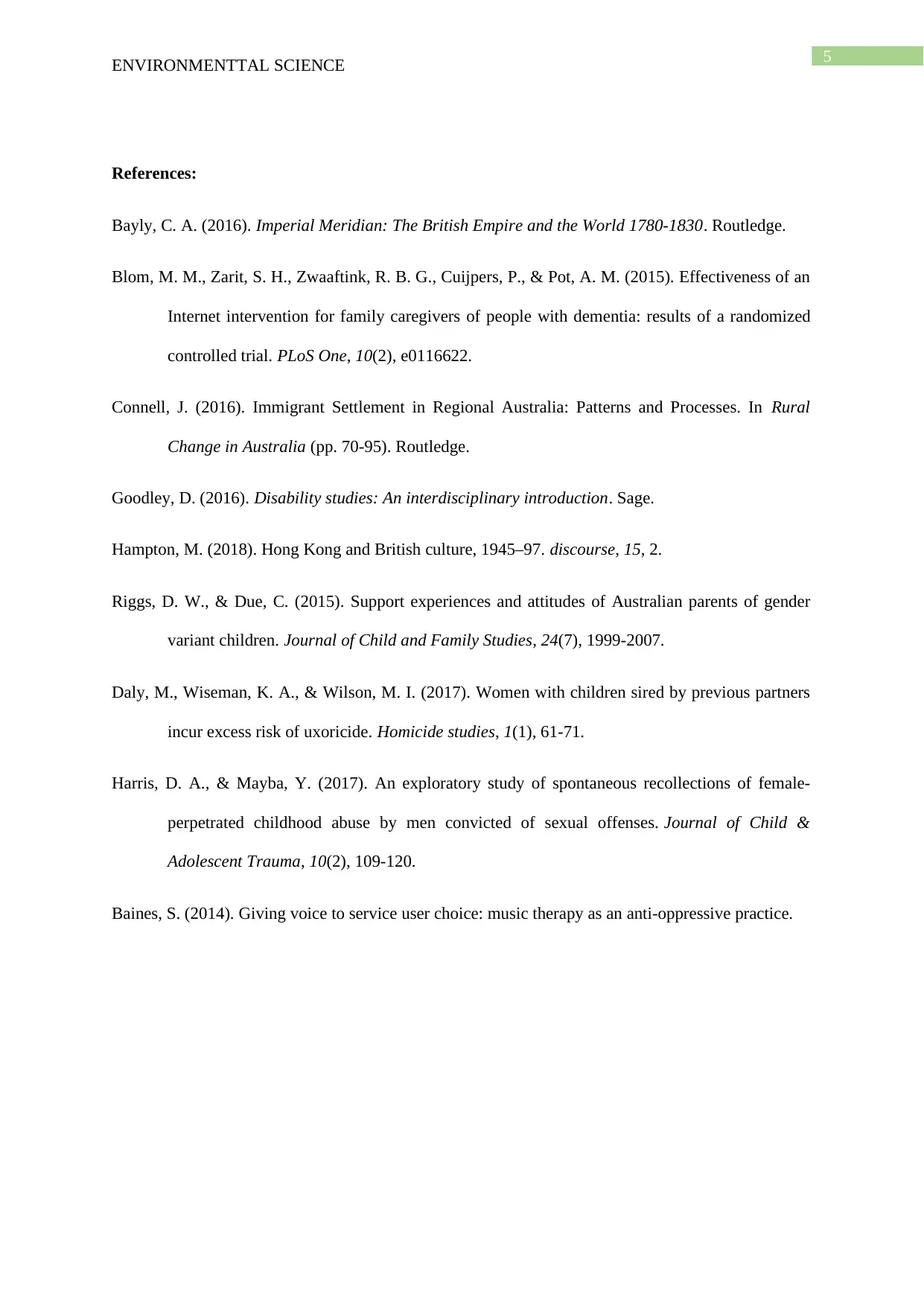
5
ENVIRONMENTTAL SCIENCE
References:
Bayly, C. A. (2016). Imperial Meridian: The British Empire and the World 1780-1830. Routledge.
Blom, M. M., Zarit, S. H., Zwaaftink, R. B. G., Cuijpers, P., & Pot, A. M. (2015). Effectiveness of an
Internet intervention for family caregivers of people with dementia: results of a randomized
controlled trial. PLoS One, 10(2), e0116622.
Connell, J. (2016). Immigrant Settlement in Regional Australia: Patterns and Processes. In Rural
Change in Australia (pp. 70-95). Routledge.
Goodley, D. (2016). Disability studies: An interdisciplinary introduction. Sage.
Hampton, M. (2018). Hong Kong and British culture, 1945–97. discourse, 15, 2.
Riggs, D. W., & Due, C. (2015). Support experiences and attitudes of Australian parents of gender
variant children. Journal of Child and Family Studies, 24(7), 1999-2007.
Daly, M., Wiseman, K. A., & Wilson, M. I. (2017). Women with children sired by previous partners
incur excess risk of uxoricide. Homicide studies, 1(1), 61-71.
Harris, D. A., & Mayba, Y. (2017). An exploratory study of spontaneous recollections of female-
perpetrated childhood abuse by men convicted of sexual offenses. Journal of Child &
Adolescent Trauma, 10(2), 109-120.
Baines, S. (2014). Giving voice to service user choice: music therapy as an anti-oppressive practice.
ENVIRONMENTTAL SCIENCE
References:
Bayly, C. A. (2016). Imperial Meridian: The British Empire and the World 1780-1830. Routledge.
Blom, M. M., Zarit, S. H., Zwaaftink, R. B. G., Cuijpers, P., & Pot, A. M. (2015). Effectiveness of an
Internet intervention for family caregivers of people with dementia: results of a randomized
controlled trial. PLoS One, 10(2), e0116622.
Connell, J. (2016). Immigrant Settlement in Regional Australia: Patterns and Processes. In Rural
Change in Australia (pp. 70-95). Routledge.
Goodley, D. (2016). Disability studies: An interdisciplinary introduction. Sage.
Hampton, M. (2018). Hong Kong and British culture, 1945–97. discourse, 15, 2.
Riggs, D. W., & Due, C. (2015). Support experiences and attitudes of Australian parents of gender
variant children. Journal of Child and Family Studies, 24(7), 1999-2007.
Daly, M., Wiseman, K. A., & Wilson, M. I. (2017). Women with children sired by previous partners
incur excess risk of uxoricide. Homicide studies, 1(1), 61-71.
Harris, D. A., & Mayba, Y. (2017). An exploratory study of spontaneous recollections of female-
perpetrated childhood abuse by men convicted of sexual offenses. Journal of Child &
Adolescent Trauma, 10(2), 109-120.
Baines, S. (2014). Giving voice to service user choice: music therapy as an anti-oppressive practice.
⊘ This is a preview!⊘
Do you want full access?
Subscribe today to unlock all pages.

Trusted by 1+ million students worldwide
1 out of 6
Related Documents
Your All-in-One AI-Powered Toolkit for Academic Success.
+13062052269
info@desklib.com
Available 24*7 on WhatsApp / Email
![[object Object]](/_next/static/media/star-bottom.7253800d.svg)
Unlock your academic potential
Copyright © 2020–2025 A2Z Services. All Rights Reserved. Developed and managed by ZUCOL.




